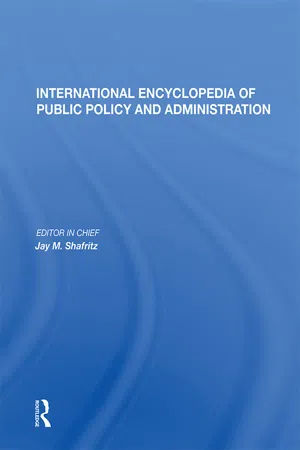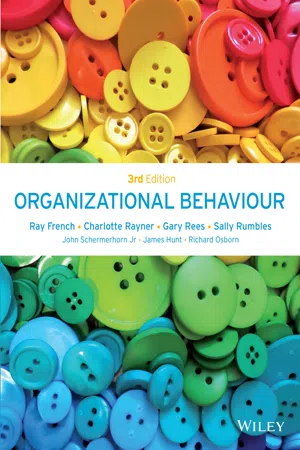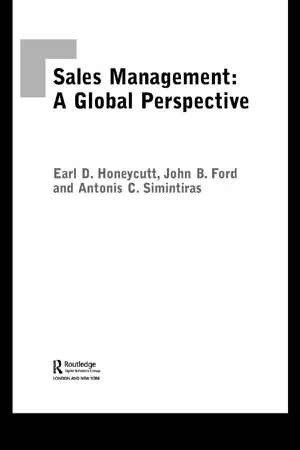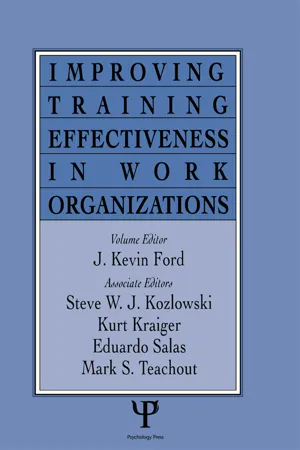Business
Expectancy Theory
Expectancy theory is a motivation theory that suggests people are motivated to act in a certain way based on the expectation of a desired outcome. It emphasizes the importance of individuals believing that their efforts will lead to successful performance and that this performance will be rewarded. The theory highlights the role of expectancy, instrumentality, and valence in driving motivation.
Written by Perlego with AI-assistance
Related key terms
Related key terms
1 of 4
Related key terms
1 of 3
8 Key excerpts on "Expectancy Theory"
- Jay M. Shafritz(Author)
- 2019(Publication Date)
- Routledge(Publisher)
However, the research was fragmented and not grounded in any solid conception of underlying theoretical processes. As Mason Haire noted in a chapter written in 1954, "Unless there is a real advance here soon, the very richness of the empirical data threatens to be overwhelming in its systematic unintelligibility" (p. 1120).Expectancy Theory was first introduced by Victor Vroom (1964) in a book entitled Work and Motivation. The purpose of Expectancy Theory was to organize existing research into a systematic framework to "show us where we now stand in our efforts to find principles and generalizations, and to indicate promising avenues for new research" (p. 5).Expectancy Theory utilizes four concepts: force, valence, instrumentality, and expectancy. The last three concepts are responsible for the frequent reference to it as VIE theory. The theory is stated in formal mathematical terms, but I will not dwell on such formality here.The theory holds that behavior is determined by the relative strength of forces acting on the person to move in different directions. Each force varies with the product of the valence of outcomes and the strength of the expectancy that the outcome will be obtained from that choice. It follows from this proposition that highly valent outcomes will have no effect on the generation of forces or on behavior unless there is some expectation that the probability of their attainment is affected by one's actions. The second proposition asserts that the valence of outcomes is dependent not only on its terminal or intrinsic properties but also on its instrumentality for the attainment of other outcomes. Specifically, the valence of an outcome increases with the product of its instrumentality for and the valence of other outcomes.Expectancy Theory is similar to and borrowed liberally from theories that had been advanced by other psychologists who had found such concepts useful in explaining other bodies of empirical evidence. Lewin (1938), Tolman (1959), Peak (1955) and Atkinson (1958) had previously demonstrated the usefulness of such concepts in explaining human action. The originality of Vroom's contribution stemmed from its application to work behavior, thereby bringing the rather atheoretical discipline of industrial psychology closer to general psychology.- eBook - ePub
- Ray French, Charlotte Rayner, Gary Rees, Sally Rumbles, John R. Schermerhorn, Richard N. Osborn(Authors)
- 2016(Publication Date)
- Wiley(Publisher)
This relationship means that the motivational appeal of a given work path is sharply reduced whenever any one or more of these factors approaches the value of zero. Conversely, for a given reward to have a high and positive motivational impact as a work outcome, the expectancy, instrumentality and valence associated with the reward must all be high and positive.Suppose a manager is wondering whether the prospect of earning a merit pay rise will be motivational to a subordinate. Expectancy Theory predicts that motivation to work hard to earn the merit pay will be low if individuals:- feel they cannot achieve the necessary performance level (expectancy);
- are not confident a high level of task performance will result in a high merit pay rise (instrumentality);
- place little value (valence) on a merit pay increase;
- experience any combination of these.
Figure 4.7 An example of individual thought processes as viewed by Expectancy Theory.Expectancy Theory is able to accommodate multiple work outcomes in predicting motivation. As shown in Figure 4.7 , the outcome of a merit pay increase may not be the only one affecting the individual’s decision to work hard. Relationships with colleagues may also be important, and they may be undermined if the individual stands out from the group as a high performer. Although merit pay is both highly valued and considered accessible to the individual, its motivational power can be cancelled out by the negative effects of high performance on the individual’s social relationships with colleagues. One of the advantages of Expectancy Theory is its ability to help managers account for such multiple outcomes when trying to determine the motivational value of various work rewards to individual employees.OB IN ACTION 4.2‘MAKING A HOLE LOT OF DIFFERENCE?’Professor Milton Fox was always known by students at the University of Wessex* - eBook - ePub
- Michael Riley(Author)
- 2018(Publication Date)
- Routledge(Publisher)
Expectancy Theory attempts to explain how a stimulus is turned into motivation or, put more simply, how a reward produces an enhanced performance. At the heart of the theory is something referred to as ‘E’. What ‘E’ stands for is a wider definition of the drive of motivation. Think of as many words as you can that are similar to ‘effort’: energy, enthusiasm, expenditure, excitement. They all infer a ‘drive’ of some kind – motivation. How is the ‘E’ to be activated? The theory suggests a number of simultaneous stages:- the strength of the need is felt;
- the expectancy that ‘E’ will produce a particular result;
- the result will reduce the need.
What is being said here is that a person has, and recognises that they have, a particular need. This need will have a certain intensity or strength to it. Management ask for more effort in return for a particular reward. The person then assesses that by expending more ‘E’ it will produce the reward and that this reward will satisfy their original need. To put it more simply – the outcome is desired, and the effort is expected to produce this desired outcome. An example would be helpful. A banquet salesperson is wondering whether or not to make a few more sales calls. The additional sales will lead to a bonus (stimulus). The salesperson is aware that they could do with the money (the need). The expectancy is that by making more calls (effort) more sales will ensue (performance) and that the bonus will be forthcoming. However, everything in this calculus is dependent upon the attractiveness of the bonus. Will the bonus reduce the need? This aspect of attractiveness of the reward is often referred to as the valence of the reward. If the bonus was trivial it would reduce the motivation force considerably. Figure 4.1 illustrates the theory.Figure 4.1 Expectancy TheoryA query, a question and a useful reminder stem from Expectancy Theory. The query is over whether people are always conscious of their needs and are as calculating and rational as the theory implies. The question that arises is where do the expectations themselves come from? On what basis do we estimate that our ‘E’ will produce the required performance and get the reward? Previous experience of ourselves in similar circumstances and previous management behaviour would seem to be our only guide. This makes consistency in evaluating performance a key area of managerial behaviour. The useful reminder which this theory flags up is that to respond to a stimulus, however subjectively, the individual must perceive it clearly, and this puts a premium on unambiguous communication. - eBook - ePub
Expectations and Actions
Expectancy-Value Models in Psychology
- Norman T. Feather(Author)
- 2021(Publication Date)
- Routledge(Publisher)
VITHE CONTEXT OF ORGANIZATIONAL PSYCHOLOGY
Passage contains an image
Terence R. Mitchell10
Expectancy-Value Models in Organizational Psychology
Expectancy Theory’s first major appearance in the organizational psychology literature was presented in 1964 in Vic Vroom’s book, Work and Motivation (Vroom, 1964). Building on some earlier work by Georgopoulous, Mahoney and Jones (1957), Vroom described expectancy type models for the prediction of occupational choice, effort on the job, and job satisfaction. These writings have had a substantial impact on the field of organizational psychology and Expectancy Theory remains as one of the two or three most heavily researched theories of motivation.Lots of work has been done since 1964 and numerous reviews of this research are available (Mitchell & Biglan, 1971; Heneman & Schwab, 1972; House & Wahba, 1972; Lawler, 1973; Mitchell, 1974; Wahba & House, 1974; Connolly, 1976; Schwab, Olian-Gottlieb & Heneman, 1979; Mitchell, 1979). Perhaps the most comprehensive review was one I wrote in 1974, which discussed the development of the theory, reviewed the results of over 50 published studies, and described a number of methodological and theoretical issues that were in need of resolution. Therefore, in this chapter I would like to use a format that first briefly summarizes the topic as of that 1974 paper and then discusses what has been accomplished since that time. Using this procedure, the theoretical, empirical, and methodological issues that have been resolved and unresolved will be highlighted. Finally, there is a section on a number of new topics that were unanticipated in the 1974 paper and that are currently important. An overall assessment concludes the chapter.THEORETICAL DEVELOPMENT
Expectancy Theory in the organizational area is similar in its underlying idea to the other theories described in this book. Lawler (1973) has stated it as follows: “The strength of a tendency to act in a certain way depends on the strength of an expectancy that the act will be followed by a given consequence (or outcome) and on the value or attractiveness of that consequence (or outcome) to the actor [p. 45].” Essentially, it is predicted that people choose behaviors that they think will result in the highest payoff for them. - eBook - ePub
Sales Management
A Global Perspective
- John B Ford, Earl Honeycutt, Antonis Simintiras(Authors)
- 2003(Publication Date)
- Routledge(Publisher)
13 attempts to explain how individuals choose between different alternative behaviors. More specifically, the theory suggests that motivation is a function of a person’s anticipation that a particular behavior will lead to outcomes that s/he values, and explains the motivation process as follows. First, individuals develop beliefs concerning the likelihood that a certain amount of effort will lead to successful performance. In other words they ask the question “Can I do it?” Then, they try to establish the link between the performance and given outcome or reward. At this stage, they address the question “What do I get for doing it?” Finally, they assess the strength of preference that is associated with each of the possible outcomes or rewards by asking, “How much do I value the reward?” Consequently, if a salesperson can perform a task and knows the kind of reward that is attached to performing the task, s/he will be motivated provided that s/he values the reward.Figure 10.2 The Expectancy Theory of motivationEffort (or motivation) is a function of Expectancy × Instrumentality × Valence, Where:Expectancy = the salesperson’s perception that effort will lead to performance,Instrumentality = the salesperson’s perception of the probability that performance will lead to certain outcomes, andValence = the salesperson’s perception of the attractiveness or unattractiveness of an outcome. (× = denotes the multiplicative nature of the relationship).The theory’s components are effort, performance, and outcome (see Figure 10.2 ). Effort is the result of motivation, performance is a joint function of effort, environment and ability, and the outcome is anything that might possibly result from performance. For example, a salesperson will be motivated when s/he values the expected rewards (e.g., promotion), believes that her/his efforts will lead to performance (e.g., can successfully engage on-the-job training of new salespeople), and the performance will result in the desired rewards (e.g., if new salespeople are trained properly and meet sales quotas s/he will be promoted). A study examining the ranking of alternative rewards in two manufacturing companies indicated that the value placed on rewards such as more pay, sense of accomplishment, and opportunities for personal growth was different among each company’s salespeople.14 - J. Kevin Ford(Author)
- 2014(Publication Date)
- Psychology Press(Publisher)
Social Learning Theory. According to social learning theory, participation in development activities is the result of employees mimicking the behavior of an organizational agent (i.e., a model; Bandura, 1986). An individual observes the behavior of the agent(s) of the organization and the subsequent outcomes that result from the behavior. The employee mimics the model’s behavior, expecting the same or similar outcomes—which serve as reinforcers of the behavior. These reinforcers can encourage or discourage the behavior, and provide valuable information on which the individual can modify his or her behavior. For example, employees who observe their peers receiving interesting and challenging job assignments as a result of their development participation may be influenced to participate if such an outcome is desired. One way internal labor market structures may influence participation decisions is through modeling behavior. If an organization hires externally for low-level positions and promotes from within for higher level positions, a newcomer may observe others to see what warrants a promotion to higher levels. If the organization rewards those who are actively developing, a newcomer may mimic that behavior to advance.Expectancy Theory. According to Expectancy Theory, participation in development is dependent on an individual’s beliefs regarding effort-performance and performance-outcome relationships, as well as the value placed on outcomes related to participation in development (Farr & Middlebrooks, 1990). The catalyst for an individual to choose to participate in development activities is motivation through expectation. If the expectations of the linkages between effort-performance and performance-outcome are positive, and if the outcome has value, an individual will be motivated.One potential reason that perceptions of supervisor or peer support are important to participation decisions is that it may impact individuals’ expectations and beliefs regarding the value of updating behavior. Using an Expectancy Theory framework, Farr and Middlebrooks (1990) suggested that supervisor and peer support may positively influence motivation because it positively impacts expectancies, instrumentalities, and valences. Employees who perceive a supportive climate for development may be more apt to believe that their participation will result in increased competence (expectancy), and that increasing competencies will result in outcomes such as promotions and salary increases (instrumentalities).- eBook - ePub
Contemporary Social Psychological Theories
Second Edition
- Peter J. Burke(Author)
- 2018(Publication Date)
- Stanford University Press(Publisher)
As such it consists of several interrelated theories, research extending and testing these theories, and research that uses these theories in social applications and interventions. How are the theories interrelated? In some cases, theories are extensions (or elaborations) of earlier theories. In other cases, later theories represent integrations of different theories in the program, and in still other cases, they are proliferations that attack new problems by building on the established concepts and principles in the program. Expectations is a key concept in the program and the program deals with different types of expectations. Performance expectations are anticipations on the part of an individual of the abilities and task capacities of self and others; reward expectations are anticipations of the rewards (or goal objects) to be possessed by self and others; and status expectations are anticipations of the status positions to be held by self and others. Different theories in the program address the sources of such expectations, whether they be interaction patterns, status differences, reward levels, or cultural beliefs; the combining (or aggregation) of such expectations if multiple ones exist in a situation; and the consequences of such expectations—for instance, how participation rates and influence patterns change among individuals as expectations form and change. In the first section, we describe the initial research in the expectation-states program on the development of power and prestige orders. In the second section, we present the core status characteristics theory, and in the third and fourth sections, respectively, theoretical extensions of that theory and theoretical integrations of that theory with other theories in the program - eBook - ePub
Psychology for Sustainability
4th Edition
- Britain A. Scott, Elise L. Amel, Susan M. Koger, Christie M. Manning(Authors)
- 2015(Publication Date)
- Routledge(Publisher)
Theories are modified over time as they are tested by scientists, and TPB is no exception. Based on empirical evidence, scholars have added components that enhance its ability to predict intentions. Notably, a good predictor of future behavior is past behavior. For instance, knowing people’s previous recycling behaviors and habits improves estimates of future recycling intentions (Knussen, Yule, MacKenzie, & Wells, 2004). The power of the TPB to predict recycling behavior is further strengthened by assessing attitudes about the typical nonrecycler (Mannetti, Pierro, & Livi, 2004). If people think negatively about a nonrecycler (e.g., lazy, immoral, clueless), they are personally more likely to recycle (Ohtomo & Hirose, 2007). Knowing whether people self-identify as environmental activists also enhances TPB predictions about proenvironmental behavior (Fielding, McDonald, & Louis, 2008).Although people like to believe that they behave in line with their attitudes, the evidence indicates that proenvironmental behaviors are only moderately related to proenvironmental attitudes (Kaiser & Schultz, 2009). The Theory of Planned Behavior lends some insight into this gap by examining attitudes alongside situational variables that can inhibit action. TPB shows that we think our way into (or out of) some of our behavior for very practical reasons.Expectancy Theory is another motivation theory that identifies perceived control as a critical feature of motivation, but defines it differently (Vroom, 1964). Control is a function of the belief that you have the ability to accomplish a particular action (recall self-efficacy from Chapter 7 ), and the belief that doing so will lead to specific outcomes deemed good, valuable, or otherwise important.Perceptions of valence, instrumentality and expectancy all need to be positive in order to create motivational force.Figure 8.8Expectancy Theory.In this theory, motivation is conceptualized as stemming from a combination of three perceptions: valence, instrumentality, and expectancy, which is why Expectancy Theory is often represented by the acronym VIE (see Figure 8.8 ). The extent to which an outcome is deemed “good, valuable, or otherwise important” represents valence
Index pages curate the most relevant extracts from our library of academic textbooks. They’ve been created using an in-house natural language model (NLM), each adding context and meaning to key research topics.
Explore more topic indexes
Explore more topic indexes
1 of 6
Explore more topic indexes
1 of 4







